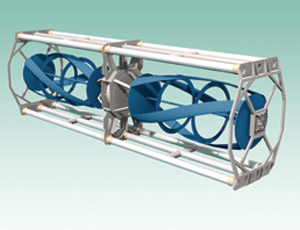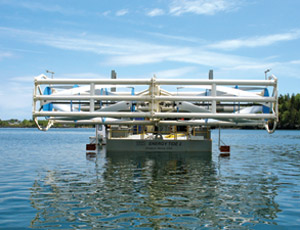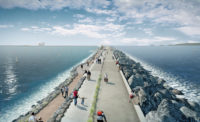Tidal power in the U.S. moved toward commercial viability this summer when Portland, Maine-based Ocean Renewable Power Co. successfully produced electric power from a tidal turbine it installed in Cobscook Bay in Eastport, Maine.


“I would say that it’s an important step forward,” says Paul Jacobsen, ocean energy leader for the Electric Power Research Institute, Palo Alto, Calif., an organization that conducts electric research and development.
It’s not the first time tidal power has been attempted in the U.S., but it is the largest project that has generated electricity, Jacobsen says. With its success, Ocean Renewable joins a small worldwide league that has successfully harnessed the power of the ocean’s tides to produce energy.
Tidal power promises to play a major role in states such as Maine and Alaska, where the sun doesn’t shine as often as it does in the South and West, therefore making solar power less viable. While it remains to be seen if tidal power can compete with other forms of generation based on installed costs, the developer hopes tidal power will be in line with the cost of wind power.
The Maine project could be a noteworthy advance. Ocean Renewable Power installed the 46-ft-wide, 14-ft-tall turbine-generating unit in March. In July, the unit started generating electricity, which is stored in batteries on a vessel that supports the 14-ton unit. This test unit has a rated capacity of 60 kW, enough to power about 20 homes.
The company’s unit works on the same principle as wind turbines, with rotating foils that power a central magnet generator. The unit is suspended from a research boat, which is powered by the turbines. Further, power is shuttled daily to a nearby 41-ft U.S. Coast Guard emergency-response ship, which uses the tidal power to remain ready for deployment 24 hours a day.
The turbines were designed in-house with assistance from the University of Maine and Bath, Maine-based U.S. Windblade, which fabricated the turbines. The proprietary design uses almost entirely composite materials and has no gears, which makes the unit resistant to corrosion; also, the unit requires no lubricants.
“It’s newer technology, but we’re borrowing and adapting a lot of technologies,” says Chris Sauer, Ocean Renewable Power Co. CEO. The company, which has been in existence for about six years, received assistance from the U.S. Navy to help determine which technologies and materials might be best for the harsh marine environment. The company has received grants from the government as it has been developing the project—the most recent a $750,000 grant in July from the Dept. of Energy because the project will help mature ocean energy to a commercially viable state.
While the pilot project will cost about $2 million, Sauer says the company’s goal is to have an installed cost of $4,000/kWh.
The company expects to begin building out a 5-MW commercial system next year. Within eight to 10 years, Sauer expects to have about 100 MW to 120 MW of tidal power systems in place off the coasts of Maine and Alaska. Each system will have a different configuration: Some would be mounted on the bottom, while others would be stacked and held in place with a mooring system.
The Maine project is one of about 20 tidal projects in the U.S. that are in some stage of development, according to preliminary tidal permits applied for or granted at the U.S. Federal Energy Regulatory Commission. New York City-based Verdant Power says it soon expects to begin building out a 30-turbine, 1-MW unit when it receives its license from FERC.
Based on the likely potential sites in the U.S.—most of them in Alaska, Maine, the Pacific Northwest and California—EPRI estimates that tidal power can generate 115 million MWh of electricity a year.
Jacobsen estimates that with an aggressive plan, 3,000 MW of tidal power could be deployed in the U.S. by 2025
Tidal power is an advantageous source of electricity because it is highly predictable for “centuries in advance” and highly concentrated—attributes that are missing in most other renewable energy, Jacobsen says. Further, the generating equipment can be located in spots where it isn’t obtrusive.
But some of the same attributes that make tidal power attractive are the same factors that make the technology challenging to deploy. Tidal power generators are difficult to site, deploy and maintain because they are in turbulent coastal waters that rise and lower several feet every day.
“It’s an important engineering challenge,” Jacobsen says.
Further, the best sites tend to be located in remote areas, such as in Alaska or Maine, making it more difficult to move electricity generated from the tidal generators to population centers.
However, Sauer says that, in Maine and Alaska, tidal power is the perfect choice for renewable electricity. “[Photovoltaic power] is never going to make it in the state of Maine,” he says. “But then again, tidal power is never going to make it in Arizona.



Post a comment to this article
Report Abusive Comment